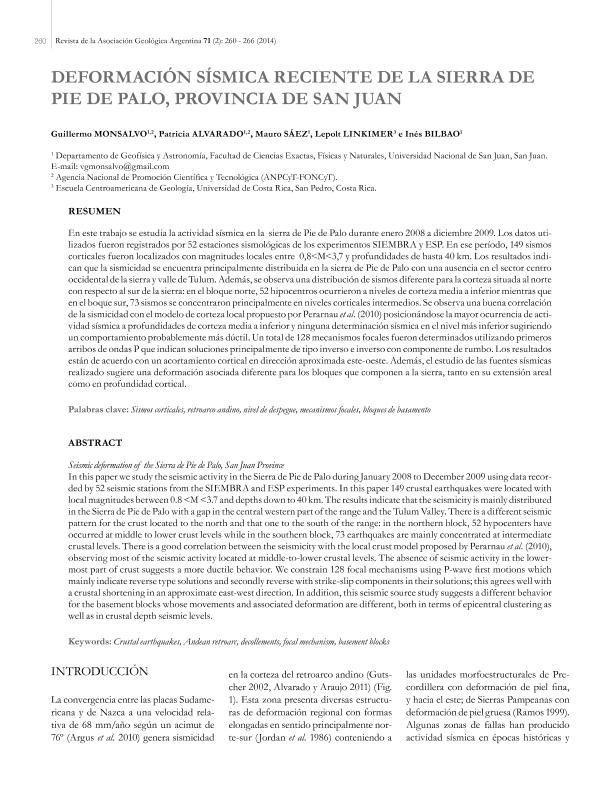Artículo
En este trabajo se estudia la actividad sísmica en la sierra de Pie de Palo durante enero 2008 a diciembre 2009. Los datos utilizados fueron registrados por 52 estaciones sismológicas de los experimentos SIEMBRA y ESP. En ese período, 149 sismos corticales fueron localizados con magnitudes locales entre 0,8<M<3,7 y profundidades de hasta 40 km. Los resultados indican que la sismicidad se encuentra principalmente distribuida en la sierra de Pie de Palo con una ausencia en el sector centro occidental de la sierra y valle de Tulum. Además, se observa una distribución de sismos diferente para la corteza situada al norte con respecto al sur de la sierra: en el bloque norte, 52 hipocentros ocurrieron a niveles de corteza media a inferior mientras que en el boque sur, 73 sismos se concentraron principalmente en niveles corticales intermedios. Se observa una buena correlación de la sismicidad con el modelo de corteza local propuesto por Perarnau et al. (2010) posicionándose la mayor ocurrencia de actividad sísmica a profundidades de corteza media a inferior y ninguna determinación sísmica en el nivel más inferior sugiriendo un comportamiento probablemente más dúctil. Un total de 128 mecanismos focales fueron determinados utilizando primeros arribos de ondas P que indican soluciones principalmente de tipo inverso e inverso con componente de rumbo. Los resultados están de acuerdo con un acortamiento cortical en dirección aproximada este-oeste. Además, el estudio de las fuentes sísmicas realizado sugiere una deformación asociada diferente para los bloques que componen a la sierra, tanto en su extensión areal como en profundidad cortical. In this paper we study the seismic activity in the Sierra de Pie de Palo during January 2008 to December 2009 using data recorded by 52 seismic stations from the SIEMBRA and ESP experiments. In this paper 149 crustal earthquakes were located with local magnitudes between 0.8 <M <3.7 and depths down to 40 km. The results indicate that the seismicity is mainly distributed in the Sierra de Pie de Palo with a gap in the central western part of the range and the Tulum Valley. There is a different seismic pattern for the crust located to the north and that one to the south of the range: in the northern block, 52 hypocenters have occurred at middle to lower crust levels while in the southern block, 73 earthquakes are mainly concentrated at intermediate crustal levels. There is a good correlation between the seismicity with the local crust model proposed by Perarnau et al. (2010), observing most of the seismic activity located at middle-to-lower crustal levels. The absence of seismic activity in the lowermost part of crust suggests a more ductile behavior. We constrain 128 focal mechanisms using P-wave first motions which mainly indicate reverse type solutions and secondly reverse with strike-slip components in their solutions; this agrees well with a crustal shortening in an approximate east-west direction. In addition, this seismic source study suggests a different behavior for the basement blocks whose movements and associated deformation are different, both in terms of epicentral clustering as well as in crustal depth seismic levels.
Deformacion Sismica Reciente de la Sierra de Pie de Palo, Provincia de San Juan
Título:
Seismic deformation of the Sierra de Pie de Palo, San Juan Province
Fecha de publicación:
05/2014
Editorial:
Asociación Geológica Argentina
Revista:
Revista de la Asociación Geológica Argentina
ISSN:
0004-4822
Idioma:
Español
Tipo de recurso:
Artículo publicado
Clasificación temática:
Resumen
Palabras clave:
Mecanismos Focales
,
Sismicidad Andina
,
Sismicidad Cortical
,
Terremotos
Archivos asociados
Licencia
Identificadores
Colecciones
Articulos(CIGEOBIO)
Articulos de CENTRO DE INVESTIGACIONES DE LA GEOSFERA Y BIOSFERA
Articulos de CENTRO DE INVESTIGACIONES DE LA GEOSFERA Y BIOSFERA
Citación
Monsalvo, Guillermo; Alvarado, Patricia Monica; Saez, Mauro; Linkimer, Lepolt; Bilbao, Inés; Deformacion Sismica Reciente de la Sierra de Pie de Palo, Provincia de San Juan; Asociación Geológica Argentina; Revista de la Asociación Geológica Argentina; 71; 5-2014; 260 - 266
Compartir




